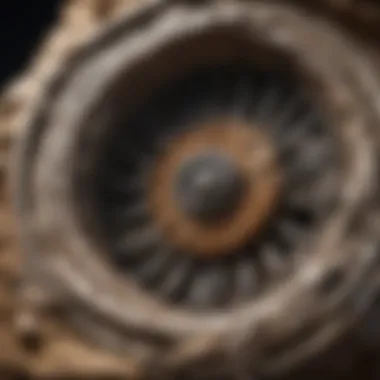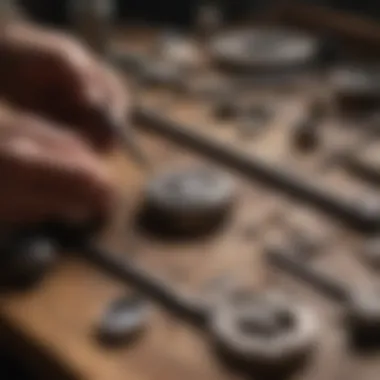Unveiling Top Fossil Repair Services Near Me: Expert Guide


Rock and Fossil Identification
When diving into the realm of fossil repair services, a crucial stepping stone is recognizing the various types of rocks and fossils one may encounter. From sedimentary to igneous rocks, and from plant fossils to intricate dinosaur remains, the diversity is immense. It's essential to understand the distinct characteristics of each type, such as texture, color, and fossilization patterns. Tools play a pivotal role in this process, with magnifying glasses, chisels, and brushes being common companions for enthusiasts seeking to identify and differentiate between various specimens.
Collecting Tips and Techniques
Moving beyond mere identification, mastering the art of fossil collection requires finesse. Best practices encompass delicate handling techniques, meticulous documentation of findings, and ethical sourcing. Knowing where to look is half the battle. Prime fossil-rich sites often lie in stratigraphically significant regions or areas with exposed rock formations. Safely extracting specimens demands patience and precision, employing tools like rock hammers, shovels, and brushes to unearth fossils without causing damage.
Preservation and Display
Preservation ensures that fossils endure the test of time, maintaining their integrity for future generations to appreciate. An array of techniques is at one's disposal, including consolidants to stabilize fragile specimens and sealants to prevent degradation. Proper storage methods involve controlled environments, such as cabinets with regulated humidity levels and acid-free materials. Creativity shines when it comes to displaying fossils, with options ranging from classic mounting frames to interactive exhibits that educate and awe viewers.
Geological Insights
Delving deeper, an understanding of geological formations and processes adds profound meaning to fossil exploration. Recognizing the historical significance of rocks and fossils unveils narratives of ancient ecosystems, climate shifts, and evolutionary milestones. Notable discoveries spark intrigue, from groundbreaking finds like Archaeopteryx to the revelation of mass extinction events. Such insights immerse collectors in the vast tapestry of Earth's geological history, enriching their appreciation for the specimens they safeguard.
Introduction
Fossil repair services play a crucial role in the preservation and restoration of precious geological specimens for avid collectors and enthusiasts. The intricate process of repairing fossils requires specialized knowledge and expertise to ensure the scientific value and aesthetic appeal of these artifacts are maintained at optimal levels. Without professional intervention, fossils are susceptible to irreversible damage and deterioration over time, highlighting the essential nature of seeking out reputable fossil repair services. This comprehensive guide aims to delve deep into the world of fossil repair services, shedding light on the significance of professional preservation for geological specimens and assisting enthusiasts in finding reputable experts to restore their prized fossils effectively.
Understanding Fossil Preservation
Fossil preservation is a crucial aspect when it comes to protecting and maintaining valuable geological specimens. The preservation process ensures that fossils remain intact for scientific study and retains their aesthetic beauty. Understanding how to preserve fossils properly involves knowledge about various factors that can impact their longevity and integrity. This section delves into the importance of preserving fossils and highlights key considerations for enthusiasts and collectors seeking to protect their cherished artifacts.
The Importance of Fossil Preservation
Preserving Scientific Value
Preserving the scientific value of fossils is paramount in the field of paleontology. By maintaining the integrity of the specimen, scientists can extract valuable information about prehistoric life forms, evolution, and Earth's history. The meticulous preservation of fossils ensures that researchers have accurate data to analyze and interpret, contributing significantly to scientific discoveries and knowledge advancement.
Maintaining Aesthetic Appeal
In addition to their scientific significance, fossils often possess exquisite beauty that appeals to collectors and enthusiasts. Preserving the aesthetic appeal of fossils involves protecting their visual qualities, such as color, texture, and overall presentation. By maintaining the attractiveness of fossils through proper preservation techniques, individuals can showcase these unique geological treasures in displays and exhibitions, enhancing their historical and artistic value.
Common Types of Fossil Damage
Cracks and Breaks


Cracks and breaks are common types of damage that fossils may experience due to geological pressure or improper handling. Addressing these issues is essential to prevent further deterioration and preserve the structural integrity of the specimen. Repairing cracks and breaks requires delicate techniques to ensure that the fossil's original form and details are not compromised.
Surface Erosion
Surface erosion can occur over time as a result of exposure to environmental elements or chemical reactions. Protecting fossils from surface erosion involves safeguarding them from moisture, sunlight, and contaminants that can degrade the outer layers. Proper cleaning and maintenance are crucial in preventing surface erosion and maintaining the overall appearance of fossils.
Mineral Deposits
Mineral deposits can form on the surface of fossils, altering their appearance and texture. These deposits may obscure details and distort the original features of the specimen. Removing mineral deposits without causing harm to the fossil requires specialized skills and understanding of the fossil's composition. By addressing mineral deposits promptly, collectors can restore the fossil's authentic look and preserve its scientific value.
Factors Affecting Fossil Deterioration
Environmental Conditions
Environmental conditions play a significant role in the deterioration of fossils. Factors such as temperature fluctuations, humidity levels, and exposure to light can impact the stability of fossil materials. Understanding how environmental conditions affect fossil preservation is crucial in implementing proper storage and display protocols to protect these precious artifacts from damage.
Handling and Storage
Proper handling and storage practices are essential in preventing physical damage to fossils. Improper handling techniques, such as dropping or mishandling specimens, can result in cracks, fractures, and other forms of damage. Implementing safe handling procedures and utilizing appropriate storage containers help ensure that fossils remain intact and retain their scientific and aesthetic value for years to come.
Choosing the Right Fossil Repair Service
In this article, the critical aspect of choosing the right fossil repair service holds paramount importance. Quality service selection can significantly impact the successful preservation and restoration of valuable fossils. By opting for reliable professionals, enthusiasts ensure that their geological specimens are handled with the expertise and care they deserve. Moreover, selecting the appropriate repair service is vital for maintaining the authenticity and value of the fossils. Each decision made during the repair process can influence the final outcome and satisfaction levels of collectors.
Researching Local Providers
Online Reviews
Discussing online reviews is essential as they offer valuable insights into the reputation and reliability of fossil repair services. Online reviews serve as a mirror reflecting the satisfaction levels of previous clients, guiding potential customers in making informed decisions. The key characteristic of online reviews lies in their transparency and real-time feedback, enabling individuals to gauge the service quality before committing. Leveraging online reviews provides a convenient and efficient method of evaluating multiple repair providers swiftly and effectively.
Referrals
Referrals play a significant role in the decision-making process when choosing the right fossil repair service. Through referrals, individuals can access firsthand testimonials and experiences, offering a personalized perspective on the capabilities of repair experts. The key characteristic of referrals is the trust factor involved, as recommendations from acquaintances or professionals in the field instill confidence in the service provider's abilities. Leveraging referrals not only simplifies the selection process but also establishes a sense of reliability and credibility within the restoration journey.
Assessing Expertise and Experience
Specialization in Fossil Repair
The specialization in fossil repair emphasizes the specific skills and knowledge required to effectively handle and restore geological specimens. Choosing a service provider with expertise in fossil repair ensures intricate details are addressed with precision, from delicate cleaning processes to intricate reconstruction techniques. The key characteristic of specialization lies in the focused attention given to the unique requirements of each fossil, guaranteeing tailored solutions that align with the preservation goals of collectors.


Portfolio of Past Work
Exploring the portfolio of past work of repair services offers a glimpse into the capabilities and craftsmanship of the experts. A comprehensive portfolio showcases the diversity in restoration projects undertaken, highlighting the range of skills and techniques employed. The key characteristic of a remarkable portfolio is its ability to demonstrate proven success in handling various types of fossil damage, instilling assurance in potential clients. Analyzing past work not only reflects the expertise of the service provider but also allows collectors to envision the transformation their fossils could undergo.
Understanding Repair Techniques
Conservation Methods
Delving into conservation methods provides an in-depth understanding of the proactive approaches taken to preserve fossils over time. Conservation methods strive to prevent further deterioration, emphasizing stability and longevity in fossil maintenance. The key characteristic of conservation methods is their emphasis on minimal intervention while ensuring maximal protection, balancing the need for preservation with minimal alteration. Incorporating conservation techniques in the repair process guarantees a holistic approach that prioritizes the sustained integrity of geological treasures.
Restoration Techniques
Exploring restoration techniques unveils the innovative strategies employed to revive and reconstruct damaged fossils to their former glory. Restoration techniques involve meticulous processes aimed at seamlessly repairing cracks, erosion, or mineral deposits, restoring fossils to their original aesthetic appeal. The key characteristic of restoration techniques is their ability to blend precision with creativity, retaining the essence and authenticity of the fossil while enhancing its visual appeal. Embracing restoration techniques during the repair journey unlocks the potential to rejuvenate fossils and revitalize their scientific and aesthetic value.
The Fossil Repair Process
In this section, we would delve into the crucial steps and procedures involved in the fossil repair process. The significance of proper handling and treatment of fossil specimens cannot be understated, especially when considering the delicate nature of these historical artifacts. By understanding the intricacies of the fossil repair process, collectors and enthusiasts can ensure the preservation and restoration of their valuable specimens for future generations to appreciate.
Initial Assessment and Consultation
Damage Evaluation
The initial assessment and consultation phase play a fundamental role in determining the extent of damage suffered by the fossil. Damage evaluation involves a meticulous examination of the fossil to identify cracks, breaks, or any other forms of deterioration. This step is essential in guiding the repair process, as it provides insights into the necessary treatments required to restore the specimen effectively. By thoroughly assessing the damage, repair specialists can develop a tailored approach that addresses specific issues, ensuring a comprehensive restoration of the fossil.
Treatment Options
After completing the damage evaluation, the next crucial aspect is determining the appropriate treatment options for the fossil. Treatment options encompass a range of methods, such as cleaning, stabilization, and reconstruction, aimed at enhancing the structural integrity and aesthetic appeal of the specimen. Each treatment option serves a distinct purpose and is selected based on the nature and extent of the fossil's damage. By carefully considering various treatment avenues, repair experts can devise a customized strategy that aligns with the preservation goals set for the fossil, ensuring a meticulous and effective restoration process.
Repair and Restoration
In this phase, the emphasis is placed on executing the selected treatment options to repair and restore the fossil to its former glory. Two primary aspects of repair and restoration include cleaning and stabilization, along with reconstruction.
Cleaning and Stabilization
Cleaning and stabilization procedures are critical in preparing the fossil for subsequent restoration tasks. Cleaning involves removing dirt, debris, or unwanted substances that may have accumulated on the surface of the specimen over time. Stabilization aims to secure any loose or fragile components of the fossil to prevent further damage during the restoration process. These procedures are essential for creating a stable foundation upon which reconstruction efforts can be successfully carried out.
Reconstruction


Reconstruction involves the meticulous process of repairing and rebuilding any damaged or missing parts of the fossil. This intricate task requires precision and expertise to seamlessly integrate new materials with the original specimen, ensuring a seamless restoration that maintains the fossil's authenticity and historical value. Reconstruction serves as the final step in the repair process, leading to the completion of the restoration efforts and the revitalization of the fossil's overall appearance.
Quality Check and Completion
As the repair and restoration work nears completion, a quality check and final inspection are conducted to assess the effectiveness of the undertaken repairs and ensure the fossil meets the desired standards.
Final Inspection
The final inspection entails a thorough review of the repaired fossil to verify that all necessary repairs have been successfully executed. This comprehensive examination is vital in identifying any remaining issues or imperfections that require further attention before finalizing the restoration process. The final inspection guarantees that the fossil has been restored to the best possible condition, ready to be appreciated and showcased.
Client Approval
Client approval marks the concluding phase of the repair process, where the restored fossil is presented to the owner for evaluation and acceptance. This step allows the client to inspect the completed restoration and provide feedback or approval on the work done. Client approval ensures customer satisfaction and affirms the successful execution of the repair process, signifying the culmination of the collaborative efforts between the repair specialists and the fossil owner.
Costs and Considerations
When delving into the realm of fossil repair services, costs and considerations play a pivotal role in decision-making. Understanding the financial aspects is crucial for clients seeking to restore their precious fossils. The importance of considering costs extends beyond the monetary value, incorporating the quality of service, expertise of the providers, and the extent of the restoration process. Clients should carefully weigh the costs against the benefits to ensure a satisfactory outcome for their cherished fossils. Transparency in pricing and a detailed breakdown of expenses contribute to fostering trust and satisfaction between clients and service providers.
Factors Influencing Repair Costs
Extent of Damage
The extent of damage to a fossil significantly impacts the overall repair costs. Extensive damage requiring intricate reconstruction and stabilization processes tends to demand higher financial investment. Factors such as the complexity of fractures, missing pieces, and structural instability contribute to elevating repair expenses. Choosing to address and rectify severe damages underscores the commitment to preserving the fossil's integrity and scientific worth. While repair costs may increase with the severity of damage, investing in comprehensive restoration ensures the longevity and value of the fossil.
Fossil Size
Consideration of the fossil size is another key determinant of repair costs. Larger fossils encompass a greater surface area and intricate details, necessitating more time and resources for restoration. The size of the fossil correlates directly with the labor involved in delicately handling and repairing it. Clients should anticipate higher costs for repairing larger fossils due to the scale of work involved. Despite the higher expenses, meticulous attention to detail in restoring large fossils exemplifies a dedication to preserving geological history and intricate formations.
Labor Intensity
Labor intensity plays a vital role in determining repair costs as it reflects the expertise and effort required to restore a fossil. Complex repairs requiring specialized techniques and skilled craftsmanship often incur higher labor costs. The meticulous handling, cleaning, and reconstruction demanded by labor-intensive repairs contribute to the overall restoration expenses. While labor-intensive repairs may entail a higher financial investment, they ensure the accurate preservation and aesthetical enhancement of fossils. Prioritizing labor-intensive techniques underscores a commitment to reviving fossils with precision and authenticity, valuing the historical and scientific significance they embody.
Budgeting for Fossil Repair
Requesting Quotes
Requesting quotes from multiple repair service providers enables clients to gauge the cost range and select the most suitable option within their budget. Obtaining detailed quotes with breakdowns of expenses aids in comparing services and understanding the value proposition offered by each provider. Clients benefit from transparency in pricing, accurate cost estimations, and clarity on the services included in the proposed quotes. Detailed quotes empower clients to make informed decisions aligning with their budgetary constraints and restoration expectations.
Insurance Coverage
Exploring insurance coverage for fossil repair can provide financial security and peace of mind to clients entrusting their valuable specimens for restoration. Insurance policies tailored to include coverage for fossil damage and restoration expenses mitigate the financial risks involved in the repair process. Clients can safeguard their investment in fossils by verifying insurance policies that extend coverage to potential damages during repair or transportation. Opting for insurance coverage reflects a proactive approach to protecting valuable fossils and ensuring a seamless restoration experience, bolstering confidence in the preservation process.
Conclusion
In delving into the expanses of fossil repair services nearby, the elucidation of a conclusion is paramount. This culmination serves as the cornerstone of the guide, encapsulating the essence of professional fossil preservation. Here, we unveil the intrinsic value of choosing the right repair service and comprehensively understanding the nuances of fossil restoration. It is crucial for enthusiasts and collectors to grasp the salience of entrusting their geological marvels to adept and experienced hands. The conclusion acts as a compass, steering readers towards a realm where the finesse of repair techniques and the meticulous process of restoration converge harmoniously. Through this definitive section, readers are bestowed with the overarching wisdom of budgeting and grasping the myriad factors that influence repair costs. Consolidating insights from the entire guide, the conclusion crystallizes the integral role that professional fossil repair plays in safeguarding and revitalizing treasured specimens, resonating with enthusiasts in pursuit of preserving their geological legacies.







